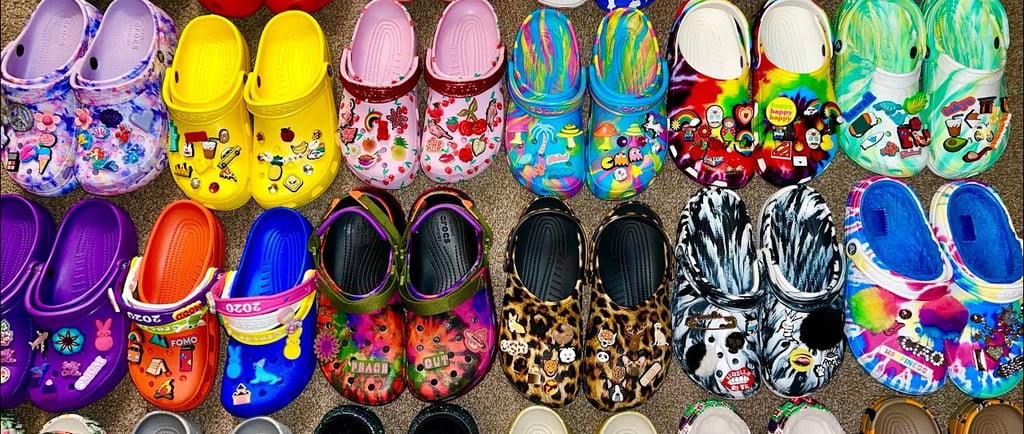👟 Welcome to Crocsy Vibe – Where Comfort Meets Global Style! 🌈
Crocs: Old Crocs, New Life - The Brand’s Sustainability Story
Make every step count with Crocs’ Old Crocs, New Life initiative. Turning retired shoes into new icons, Crocs combines classic comfort with bold sustainability—inviting you to join a movement where your favorite footwear never goes to waste. Experience fashion that feels good for you—and even better for the Earth.
SHARAD RAJGURU
7/22/20258 min read


Introduction to Crocs' Sustainability Journey
Crocs, a global leader in footwear, has embarked on a transformative journey toward sustainability, reflecting an increasing commitment to eco-friendly practices in today's marketplace. Recognizing the pressing need for environmental stewardship, the brand has integrated sustainable practices into its core operations and product development. This shift is particularly significant in the footwear industry, which has historically faced scrutiny for its substantial environmental impact. By embracing sustainability, Crocs aims to align its business objectives with a responsibility towards the planet.
The initiative demonstrates a clear understanding of the environmental challenges facing the world. Crocs has implemented a variety of innovative strategies to minimize its environmental footprint, showcasing how the brand can adapt while still delivering high-quality, comfortable footwear. From using renewable materials to enhancing energy efficiency in their production processes, Crocs has prioritized reducing waste and sourcing sustainable inputs. These steps indicate a shift towards a circular economy, where products are designed for longevity and recyclability.
Moreover, Crocs’ sustainable journey highlights the importance of transparency in the supply chain. The brand focuses on fostering partnerships with suppliers committed to eco-friendly practices, ensuring that sustainability is a foundational element at every stage of production. This commitment not only helps preserve the environment but also positions Crocs favorably among consumers who are increasingly looking for brands that prioritize sustainability.
As the conversation around environmental responsibility grows, Crocs stands at the forefront, redefining what it means to be a responsible footwear brand. The company’s proactive approach to sustainability serves as an inspiration for other brands within the industry, illustrating the potential for innovation and responsibility to go hand in hand. As we delve deeper into Crocs' sustainability initiatives, it becomes evident that their commitment goes beyond mere branding—it's about creating a lasting impact on the planet.
The 'Old Crocs, New Life' Initiative
The 'Old Crocs, New Life' initiative represents a pivotal move by Crocs to foster sustainability while engaging its customer base in environmentally responsible practices. Launched as part of the brand's broader commitment to reduce waste and promote recycling, this program encourages customers to return their worn-out or unused Crocs. By participating in this initiative, consumers play a crucial role in the brand’s sustainability efforts and contribute to a circular economy.
Under this program, customers can conveniently return their old Crocs at designated collection points or through special mailing options provided by the company. Once collected, the returned footwear undergoes a meticulous recycling process aimed at transforming the materials into new products, thus minimizing landfill waste and reducing the need for new raw materials. This innovative approach not only extends the lifecycle of the footwear but also highlights the importance of recycling in today’s fast-paced fashion culture.
Beyond its environmental benefits, the initiative serves dual purposes; it instills a sense of collective responsibility among consumers while reinforcing Crocs' dedication to sustainability. Many customers appreciate the opportunity to return their Crocs as it allows them to contribute directly to reducing their ecological footprint. Through the 'Old Crocs, New Life' program, the brand has established a method that is both pragmatic and impactful, encouraging individuals to think critically about waste and the importance of recycling.
By capitalizing on customer participation, Crocs enhances the community’s involvement in achieving sustainability goals. This initiative exemplifies a progressive step towards a more eco-friendly future, demonstrating how brands can inspire and mobilize customers for the greater good. The 'Old Crocs, New Life' initiative is not merely a recycling program; it signifies a commitment to environmental stewardship and sustainable practices that resonate deeply within the modern consumer landscape.
Understanding the Circular Economy Concept
The concept of the circular economy represents a significant shift from traditional linear economic models, which typically follow a take-make-dispose pattern. In essence, a circular economy aims to create a restorative system that minimizes waste and reduces the consumption of finite resources. This is achieved by emphasizing the importance of sustainable production, responsible consumption, and product lifecycle management. The primary objective is to extend the lifecycle of materials and products by promoting reuse, recycling, and reducing their environmental impact.
One of the primary benefits of the circular economy is its potential to conserve resources and reduce greenhouse gas emissions. This model encourages companies to design products that can be easily repaired, reused, or recycled, thereby decreasing the demand for new raw materials. The adoption of such an economy can also stimulate innovation within industries, leading to the development of new materials and processes that are both efficient and environmentally friendly.
In recent years, Crocs has begun transitioning from a linear approach to a more circular model, significantly impacting its sustainability practices. By focusing on reducing waste and promoting responsible sourcing, the brand is aligning with circular economy principles. This shift is reflected in their initiatives to utilize recycled materials in the production of new footwear, as well as their recycling programs aimed at encouraging consumers to return old Crocs for repurposing or recycling.
Through these efforts, Crocs is setting an example within the fashion industry by demonstrating that embracing circular economic principles not only fosters environmental responsibility but also enhances brand loyalty among consumers who increasingly value sustainability. By rethinking product design and lifecycle management, Crocs is contributing to a broader movement toward sustainability in fashion and setting a benchmark for others to follow.
The Upcycling Process: Transforming Old into New
In an era where sustainability has become a top priority for consumers and brands alike, Crocs has taken significant strides in addressing the environmental impact of footwear production through its innovative upcycling process. Upcycling, the practice of transforming waste materials into new, higher-quality products, plays a pivotal role in Crocs’ sustainability strategy. This approach not only reduces waste but also creatively reimagines the life cycle of Crocs footwear.
The journey of upcycling begins when customers return their old or unused Crocs shoes. Instead of ending up in landfills, these shoes are collected and processed in dedicated facilities. The first step involves sorting and assessing the returned footwear to determine the best possible repurposing options. Through careful inspection, Crocs aims to salvage as many materials as possible, maximizing the potential for reuse.
Once sorted, the shoes undergo a meticulous transformation process. Depending on their condition, various components such as the Croslite material, straps, and other parts are reclaimed and integrated into new designs. Crocs has developed a range of creative products from upcycled materials, including stylish accessories and home goods, showcasing the versatility of what was once considered waste. This ingenuity not only minimizes environmental impact by diverting waste from landfills but also highlights the brand's commitment to innovation and sustainability.
Moreover, Crocs' upcycling initiatives encourage a circular economy, wherein materials are continuously reused to create new products. This progressive approach reinforces the brand's dedication to environmental stewardship while offering customers an opportunity to participate in sustainable practices. By embracing the upcycling process, Crocs demonstrates that sustainability can be stylish, functional, and accessible, enriching the lives of consumers while caring for the planet.
Environmental Impact: Reducing the Fashion Footprint
The fashion industry is notorious for its substantial environmental impact, contributing significantly to pollution and landfill waste. Crocs' initiative, 'Old Crocs, New Life,' seeks to address these issues by implementing a circular model, which emphasizes reuse and recycling. This innovative program allows customers to return worn-out Crocs for repurposing, ensuring that less material ends up in landfills. In an age where sustainability is becoming increasingly crucial, such initiatives are not only beneficial but necessary for the future of the footwear sector.
According to statistics from the Environmental Protection Agency (EPA), textile waste accounts for approximately 5% of all landfill space in the United States. By fostering a culture of recycling, the Crocs initiative can significantly mitigate this impact. Projections suggest that if more companies, like Crocs, adopt similar circular economy practices, we could see a drastic reduction in the approximately 17 million tons of textile waste generated annually. This transition towards a circular model aims to create a more sustainable lifecycle for footwear, moving away from the traditional linear approach that ultimately harms the environment.
Additionally, the ecological benefits extend beyond waste reduction. By utilizing recycled materials from returned Crocs to create new products, Crocs is significantly lowering its carbon footprint. Studies indicate that recycling plastics and other materials requires considerably less energy than producing new ones. Thus, the 'Old Crocs, New Life' initiative not only contributes to landfill diversion but also supports a greener manufacturing process, aligning with global goals to reduce greenhouse gas emissions and promote environmental stewardship.
Through this progressive approach, Crocs exemplifies how companies can take concrete steps towards sustainability, ultimately shaping a more responsible footwear industry while encouraging consumers to engage in eco-friendly practices. This shift is pivotal for fostering a better future environmentally, paving the way for the next generation of conscious consumers and brands alike.
Crocs' Commitment to Sustainability Beyond Shoes
Crocs has diligently sought to enhance its sustainability efforts, extending beyond its notable takeback program. The company has embraced a multifaceted approach to sustainability, which includes significant advancements in material innovation and eco-friendly production practices. These efforts serve to underline Crocs' commitment to environmental stewardship, responding to the growing consumer demand for responsibly produced products.
One of the core pillars of Crocs' sustainability strategy is its focus on material innovation. The company has made considerable strides in developing sustainable materials that minimize environmental impact. For instance, Crocs has begun to integrate bio-based and recycled materials into its products. This transition not only lessens dependency on fossil fuels but also reduces waste in landfills. The incorporation of these alternative materials equips Crocs with the flexibility to produce a durable product while adhering to regenerative practices that benefit the environment.
Furthermore, Crocs prioritizes eco-friendly production practices. The company works closely with its manufacturing partners to ensure the adoption of processes that lower carbon footprints. By investing in energy-efficient technologies and sustainable sourcing of raw materials, Crocs aims to minimize pollution and conserve water, setting industry benchmarks for sustainable manufacturing. Additionally, Crocs evaluates its supply chain to identify areas for improvement, aiming for transparency and accountability in its operations.
Crocs also incorporates sustainability goals into its broader corporate strategy, establishing clear benchmarks for success in reducing environmental impact. The company has committed to significant reductions in greenhouse gas emissions and aims to achieve a circular economy by ensuring that all of its products are recyclable or compostable by 2030. Such initiatives reflect Crocs' dedication to fostering a sustainable future while continually enhancing its product offerings and brand identity.
Conclusion: Stepping into a Greener Future
As we reflect on the sustainability journey of Crocs, it is evident that the brand has made significant strides toward a more environmentally friendly approach to footwear production. By embracing innovative materials, promoting recycling, and committing to carbon-neutral operations, Crocs demonstrates that the footwear industry can adapt to meet the growing demand for sustainable practices. This shift not only enhances the brand’s image but also resonates with consumers who are increasingly concerned about the environmental impact of their purchases.
Moreover, the involvement of consumers plays a crucial role in the success of such sustainability initiatives. By choosing brands that prioritize eco-friendly practices, individuals can influence the market and encourage more companies to follow suit. Each purchase made with sustainability in mind contributes to a larger movement that advocates for responsible consumption. Crocs' efforts to recycle old shoes and reduce waste serve as a call to action for consumers to reassess their footwear choices, highlighting the profound impact that informed purchasing decisions can have on the planet.
The journey toward sustainability is not solely the responsibility of the brand. It is a collective effort that requires the participation of consumers willing to support environmentally conscious companies. By advocating for sustainable options, customers can drive demand for innovative practices that minimize ecological footprints. In promoting awareness around sustainability in the footwear industry, Crocs sets an example, encouraging consumers to reflect upon their choices and foster a marketplace where sustainability is prioritized.
Ultimately, by stepping into a greener future together, both brands and consumers can create a more sustainable world, ensuring that the environmental challenges we face today do not become insurmountable obstacles for generations to come.

Get in touch
Address
3721 Single Street
Quincy, MA 02169
Contacts
123-456-7890
info@email.com
